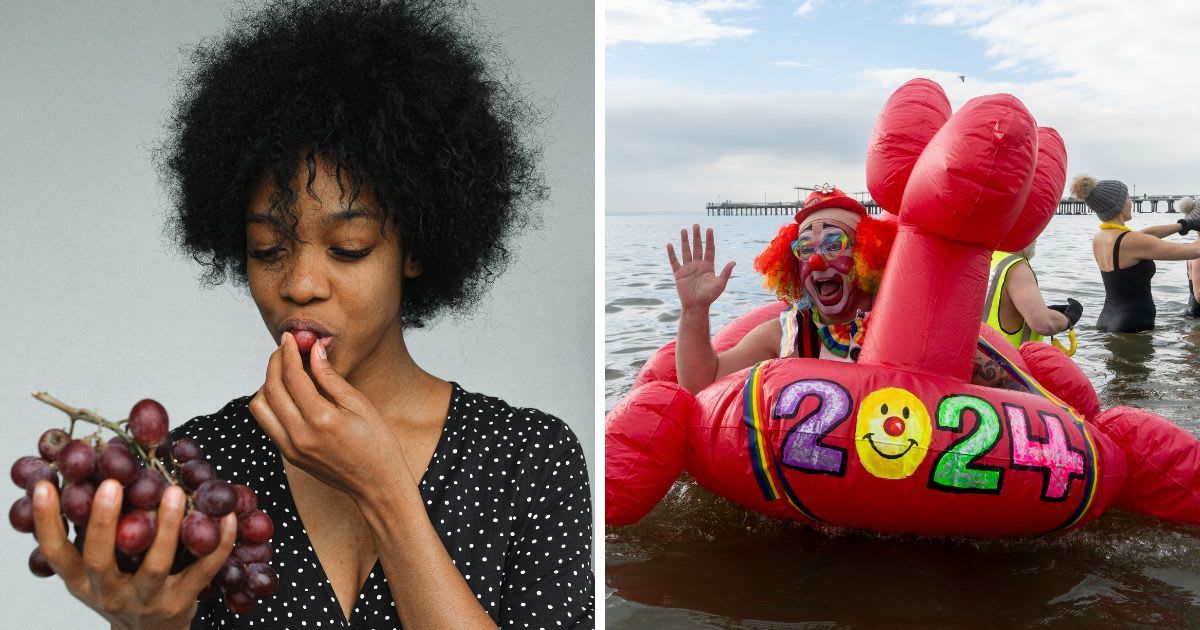10 weird New Year's rituals from around the world: From eating 12 grapes to annual polar bear plunge

10 weird and wonderful New Year's customs from across the world

As a new year begins, to wish good fortune for the upcoming 365 days, people around the world perform various rituals on January 1. Be it swimmers braving the freezing sea on New Year's Day in New York or people stuffing themselves with grapes in Spain, the fascinating traditions help in having a fresh start. Here are 10 of the most bizarre and interesting customs that are observed globally to greet the new year.
Polar bear plunge: New York and Boston

In the eagerness to welcome the New Year, thousands of New Yorkers braved the frigid Atlantic Ocean waves at the Coney Island Polar Bear Plunge on Monday, January 1, when the temperature was in the mid-to-low 40s, as per the Daily Mail. While some opted for a more celebratory look with costumes, wigs, head masks, makeup, and colorful, huge floats, others donned basic swimwear to ring in the New Year. In 2023, the Coney Island Polar Plunge was able to draw about 4,000 people.
108 bell rings: Japan

In Buddhist temples around Japan, bells are rung 108 times at midnight on Japanese New Year's Eve aka Oshogatsu, to ward off the 108 malevolent temptations that exist in all people. The Japanese think that they will atone for their transgressions from the previous year by ringing the bells. On the final day of the year, the bell is traditionally rung 107 times, and on the 108th toll, the New Year is ushered in.
12 grapes of luck: Spain

Eating 12 grapes on New Year's Eve—one for each strike until midnight—is a custom in Spain meant to bring luck and wealth. People are believed to have luck in the upcoming year if they can complete consuming them on time. Whether the grapes are sour or sweet, their flavor also portends the year ahead. The custom known as "las doce uvas de la suerte," or "the twelve grapes of luck," is said to have started in 1895 and became popular in 1909 at Madrid's Puerta del Sol public area, where the iconic clock tower continues to chime at midnight.
Wearing underwear of a specific color: Latin America

The color of the underwear determines the fortune for the coming year in Latin American countries, including Bolivia, Brazil, and Mexico. According to an urban legend, yellow will bring money, and red will bring love. On the other hand, the color white works well for people looking for harmony and tranquility. Thus, individuals essentially select the color of their underwear based on their goals for the upcoming year.
Smashing dishes: Denmark

As part of a Danish custom, people smash dishes and crockery against their neighbors' doors to wish them luck for the upcoming year. Unused dishes are kept throughout the year and thrown at the front doors of friends and family on December 31. Larger shattered china piles are believed to portend more friends and good fortune for the forthcoming year. Danes also like boiling fish with mustard for their traditional New Year's Eve dinner, which is followed by kransekage or marzipan doughnuts.
Mistletoe and bread: Ireland

In Irish mythology, mistletoe is a berry linked to fertility. Single women in Ireland have been known to place it beneath their pillows on New Year's Eve. The following day, they set it ablaze in the hopes of attracting love in the upcoming year. Another New Year's custom is to ward off bad luck and evil spirits by pounding bread on doors and walls. Some even substitute the bread for pots, pans, and wooden spoons.
Tossing furniture out of the window: Italy

The saying "Out with the old" is popular in parts of Italy, like Naples, where it is customary to toss old, undesired furniture out balconies on New Year's Eve as a way to mark a new beginning for the coming year. While most residents limit their tossing ritual to small, soft objects to prevent accidents, it is always a good idea to exercise caution if strolling through Naples on New Year's Eve.
First-footing: Scotland

The "first-foot" also known as quaaltagh or qualtagh, is one of the oldest customs in Scotland. It states that the first person to cross the threshold of a household after midnight on New Year's must bring gifts. To provide the best luck to the house, these gifts can include cash, coal, bread, salt, and whiskey. Traditionally, a tall, dark-haired male is usually chosen as the one to enter the household to call in prosperity and luck.
Dressing up as bears: Romania

People dress up as bizarre animal-spirit amalgamations as part of various traditional rituals around Europe on New Year's, and the bear is in charge in Romania. Having said that, animal rights organizations have objected to the practice of groups dancing through the streets dressed as bears during several end-of-year festivals and parades. This is because many use costumes made of real bearskin inherited from old families while participating in the event. The annual Dancing Bear event signifies warding off evil spirits before the start of a new year.
Round things: Philippines

The New Year's is all about round things in the Philippines. In particular, it concerns money, but analogies may be seen in everything, from a feast of 12 round fruits to clothing with polka dots. All of this is to maintain the flow of revenue. The Filipinos think that if they surround themselves with round objects, it will bring them wealth and money in the coming year. Some people go as far as filling up their pockets with coins or scattering them all over their homes to bring in luck.










